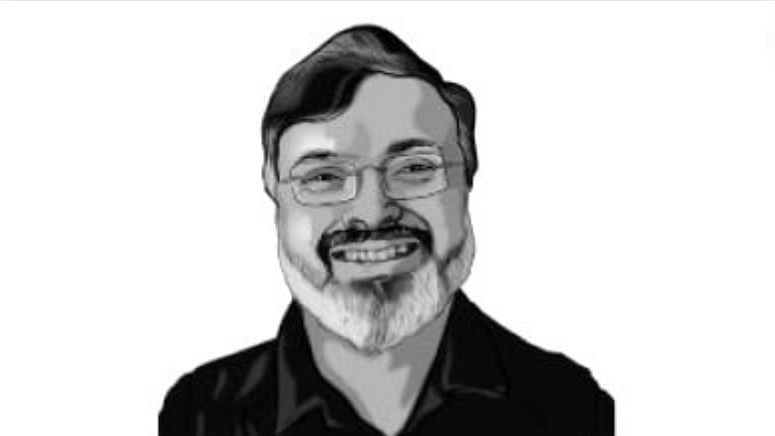
Devdutt Pattanaik Works with gods and demons who churn nectar from the ocean of Indian, Chinese, Islamic, Christian, even secular mythologies
DH Illustration
At this moment, there are archeologists in India who are being gently nudged to prove that ‘Saraswati’ was the original civilisation of the world that thrived in Haryana even before Indus civilisation (located in Pakistan). Meanwhile, in the UK, there are professors who are trying to prove the link between lactose tolerance (Aryan gene) with colonialism. The argument about immigrants being invaders is back.
A few years ago, Yuval Noah Harari’s bestselling book Sapiens: a brief history of humankind, explained why 19th century Europeans who popularised racism, and the idea of White Supremacy, referred to themselves as Aryans. “They noticed that the earliest Sanskrit speakers, who had invaded India from Central Asia more than 3,000 years ago, had called themselves Arya.”
In the same book, when he spoke of imagined hierarchies in society, he conflated Indian casteism with Ottoman religious discrimination, with American racism, and said, “For instance, many scholars surmise that the Hindu caste system took shape when Indo-Aryan people invaded the Indian subcontinent about 3,000 years ago, subjugating the local population.” In both cases, he presented Aryan Invasion Theory (AIT) as fact, though it has been discredited by scientists. Hindu nationalists prefer the word ‘debunked’.
But ‘debunking’ AIT is always followed by the highly imaginative Out of India Theory (OIT). If Aryans did not invade India, then Aryans must be Indians! And they must have migrated out of India to Europe, taking Sanskrit language and civilization to the world. This kind of simplicity is easy to digest, indulges the inferiority complex of many elite Hindus, especially those who have given up Indian passports to reside in the UK and US, and so is highly popular.
Neither Harari nor the OIT advocates are interested in the peer-reviewed, less dramatic AMT or Aryan Migration Thesis, established thanks to ancient DNA studies, globally available since 2010. AMT clarifies that Aryan invasion, or rather immigration, did happen, but centuries after the fall of Harappan civilization in 1900 BC. There is a clear shift in India’s gene-pool after 1500 BC. A foreign gene now seen across North Indians and elite South Indians. Also, it is around 2000 BC, that horses were domesticated (as per DNA studies) and spoked-wheel chariots invented (as per archeology) in Eurasia. The horse-praising Vedic hymns could only have been composed much later.
So Aryans did not come 4,000 years ago (when Harappan cities were declining). They came roughly 3,000 years ago (when Harappan cities were long gone). Then, roughly 2,500 years ago, the word Arya was used as a title by the Buddhist, Jain and Brahmin elite. Less than 2,000 years ago, caste endogamy began, as per DNA studies. This was due to changes in the agricultural economy, not invasion. Clubbing the fall of Harappa with the rise of caste is just fantasy, as is the idea that Aryans and horses are indigenous.
Facts muddy the thesis. They complicate the story. They do not fuel political change. In the nationalist worldview, Vedic civilization is Hindu civilization which includes Buddhists, Jains, Sikhs, everyone who lives in India, including Dravidian speakers, and those who identify themselves as Dalits and tribals. Such a narrative can inspire and mobilise a country, just as the vision of the Caliphate mobilises Islamists. Such visions can be found in China, in Japan, in Israel. Americans fear the Critical Race Theory as it has the power to make young Americans hate America. We need narratives that make us feel good, rather than evoke reflection.
OIT enthusiasts never talk to Iranians as to how Persia was renamed Iran in 1935, by the Shah, under Nazi influence, because Iran is derived from Ariyan. In the 2500-year-old Behistun inscription, the Persian Emperor Darius described himself as Aryan. He was probably referring to the Avesta, a Zoroastrian scripture, that described that region as ‘expanse of Aryans’. Darius was using his Aryan roots to declare his power over Central Asian nomads. The 20th century renaming of Persia also served a political need to sever links with Arabs. The narrative did not care for historical accuracy. What mattered was its ability to mobilise a people. The narrative is so popular that in 2004, football fans in Iran gave the Nazi salute to a visiting German team. The Iranians thought they were showing respect. The German players were mortified.
Why did Harari use a debunked thesis as fact? Because it served his argument. His book speaks of how imaginary stories enabled humans as a species to collaborate and take up massive projects. This, along with technology, he argues enabled the human species to dominate the earth. But he does not distinguish between mythology (long-term matters of faith) and propaganda (short-term tools of social manipulation). Marx also did not differentiate. Nor did Foucault, or Derrida.
Academics, who accuse others of using imaginary stories and manipulating social constructs, need funding from politicians who have an agenda, so they select facts and present ideas to suit the ideology. They insist their story is more fact-based, more noble, less manipulative. Thus do humans fool themselves.